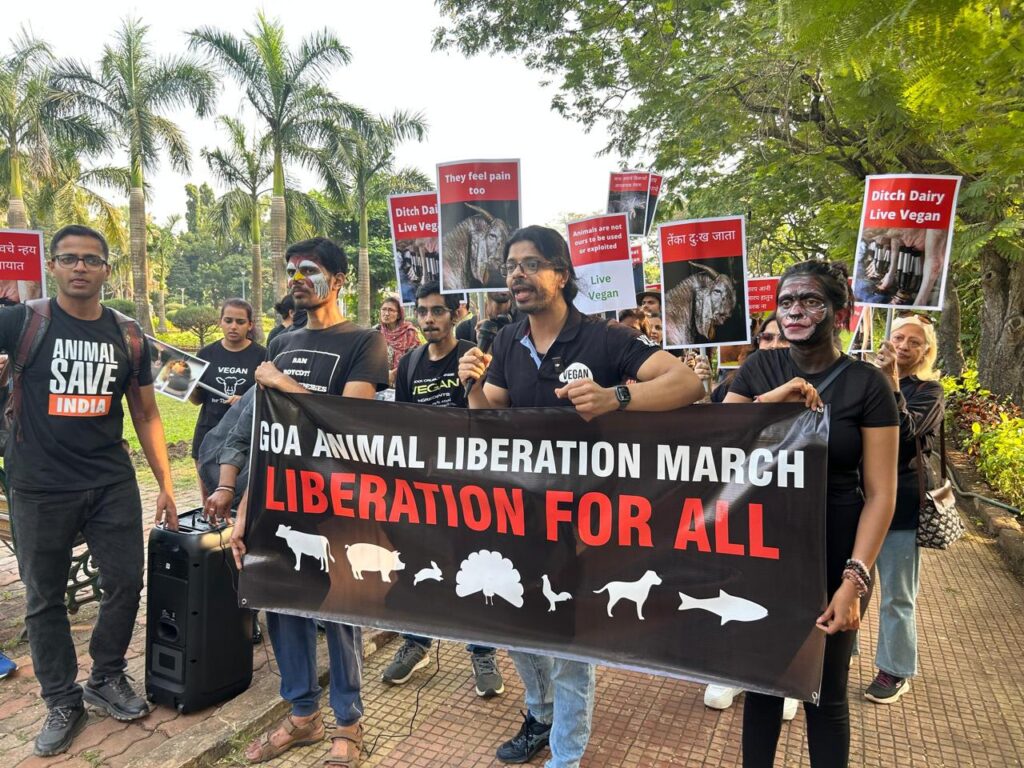
PANAJI: To demonstrate that animal liberation and human liberation are interconnected and inseparable, the Goa Animal Liberation Movement organized the annual Goa Animal Liberation March on Saturday to raise awareness about animal liberation and to end the prejudice of speciesism prevalent in society.
The march, which began at Dr Babasaheb Ambedkar Park and concluded at Azad Maidan, featured animal liberation activists from various cities nationwide chanting animal rights slogans. Some activists painted their bodies to represent animals exploited for needless human wants, emphasizing the need to eradicate the unnecessary torture and exploitation of sentient fellow Earthlings.
“Every sentient being, human or non-human, deeply cherishes and deserves the right to live freely on this planet. We have an ethical responsibility not to rob them of this fundamental right. Why should justice and compassion be limited to humans when animals too can suffer acutely, both mentally and physically? In the enduring words of a famous philosopher, regarding our duty to not cause suffering, the question is not ‘Can they talk or reason?’ The only relevant question is ‘Can they suffer?’” said Gemini Xettigar, activist and organizer of the event.
The event aimed to help people understand how humans have created an arbitrary, imaginary divide, leading to discrimination against non-human animals who are no different from humans in their ability to feel complex emotions such as joy, pain, and sorrow, and how all of them have a right to live, Xettigar explained.
The Goa Animal Liberation Movement is a group of grassroots animal liberation activists in Goa who seek to draw parallels to the recently celebrated Goa Liberation Day, commemorating freedom from the erstwhile Portuguese colonial regime.
“Atrocities like slavery were once so embedded in the collective consciousness that they were thought to be eternal. But history has shown that positive change can be achieved even when oppression seems deeply ingrained and pervasive,” said Trisha Bene, a volunteer at the Goa Animal Liberation Movement, urging everyone to help eliminate the lifelong suffering that our choices inflict on trillions of animals.
Discussing the event further, Bene said, “Speciesism is a prejudice that wrongfully disregards the lives and interests of non-human animals simply because they belong to another species. It is analogous to sexism, racism, casteism, and other forms of oppression, as it also involves an ethically irrelevant criterion—species membership—to harm innocent sentient beings. As part of our ethical responsibility to practice and promote progressive values, we must shun and speak against the exploitation of animals too.”
Daniel Thomas, a co-organizer, stated, “We care about being against oppression. Yet what we do to these animals in slaughterhouses is oppression. So if you truly believe that oppression is wrong, then you have to be vegan.”
“There is a perception that vegans are people who don’t consume milk. But this is not the only reason. We exploit animals and commit atrocities against them. Veganism is a means to end this. Humans think animals are to be used for our benefit. However, this is incorrect. We should give the same respect to animals as we give to people. Animals have feelings; they have families. When we hurt them, they feel pain. Just as we fight against discrimination among people, we should similarly fight against prejudice between animals and humans,” said one activist.
Reflecting on his personal transformation, Thomas shared, “I was raised non-vegetarian, but I turned vegan after recognizing the completely unnecessary suffering that our choices inflict on helpless animals. Being vegan is not a diet; it is a stance, a means of ensuring, to the greatest extent practically possible, that animals are not exploited or otherwise harmed by our actions for any purpose. Apart from not eating meat, eggs, dairy products/milk, and honey, being vegan also involves avoiding leather, wool, silk, fur, pearls, zoos, animal circuses, animal-tested cosmetic products, etc.”
